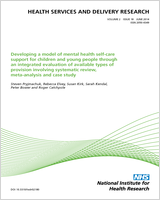Included under terms of UK Non-commercial Government License.
NCBI Bookshelf. A service of the National Library of Medicine, National Institutes of Health.
McCourt C, Rayment J, Rance S, et al. An ethnographic organisational study of alongside midwifery units: a follow-on study from the Birthplace in England programme. Southampton (UK): NIHR Journals Library; 2014 Mar. (Health Services and Delivery Research, No. 2.7.)

An ethnographic organisational study of alongside midwifery units: a follow-on study from the Birthplace in England programme.
Show details- Alongside midwifery units
These provide labour and birth care led by midwives for women categorised as at low risk. They provide a distinct service but are proximate to obstetric-led maternity units, most often within the same building.
- Advanced Life Support In Obstetrics
An example of a multidisciplinary, practice-based course which has been shown to be effective in preparing maternity teams for working together in obstetric emergencies.
- Band 7 midwife
Midwifery staffing in the UK at the time of publication was graded in bands, normally from band 5 (newly qualified midwife) to band 8 (usually more senior managerial roles). A band 7 midwife has some additional responsibilities such as co-ordination or shift leader roles. Some AMUs have a band 7 midwife in their specific lead role.
- Birth centre
This is a more popular and widely used term for a midwifery unit, either alongside an obstetric unit or as a free-standing midwife unit, and is used interchangeably with these terms.
- Cardiotocograph
A device used to monitor fetal heartbeat and uterine contractions during labour. The CTG can be used on admission, intermittently or continuously. Best clinical evidence indicates that routine use of CTG for women with straightforward healthy pregnancies does not confer benefits and may carry risks. However, routine use of continuous CTG is common in many obstetric units in the UK.
- Free-standing midwifery units
These provide labour and birth care led by midwives for women categorised as at low risk. They provide a distinct service, on a separate site from obstetric-led maternity units, such that if transfer is required, it would be by car or ambulance. Midwifery units on the same site as community hospitals or clinics without an obstetric unit are categorised as free-standing.
- Low risk
Women are normally categorised as at low risk in the UK if they do not have any of the conditions set out in National Institute for Health and Care Excellence Intrapartum Guidelines risk assessment regarding advice on planned place of birth. The term ‘low-risk’ is also sometimes used to refer to care pathways, guidelines or protocols designed for the maternity care of women at low obstetric risk.
- High risk
Women in the UK are normally categorised as at increased risk of birth complications if they have any of the conditions set out in National Institute for Health and Care Excellence intrapartum guidelines risk assessment regarding advice on planned place of birth as warranting birth in an obstetric unit. In practice, the term high risk is more commonly used than at increased risk.
- Normal birth
This term is in common use by professionals and the public to refer to labour and birth that takes place physiologically and without obstetric interventions. However, it is often used simply to refer to vaginal birth without instruments (use of forceps or ventouse). There is also a more restrictive definition of normal birth agreed by a UK National Consensus Working Party.
- Obstetric unit
A labour ward within a hospital that provides obstetric services (facilities and doctors including obstetricians and anaesthetists) as well as antenatal and postnatal care. The ward for labour and birth is more commonly referred to as a ‘labour ward’, ‘delivery suite’ or ‘hospital birth centre’. Obstetric care is led at consultant level. A woman developing complications during labour or birth in an obstetric unit would not normally require transfer elsewhere, except in rare cases of more specialist maternal or neonatal care being required. Individual women who are ‘low-risk’ may receive care led by midwives within an obstetric unit, particularly those requiring epidural anaesthesia.
- Pinard stethoscope
This is a low-technology instrument used mainly by midwives for intermittent monitoring of the fetal heartbeat during labour. Midwives may also use a Doppler fetal monitor (a ultrasonography device) as an alternative method of monitoring the fetal heartbeat intermittently.
- PRactical Obstetric MultiProfessional Training
An evidence-based multiprofessional training package for obstetric emergencies.
- Strengths, weaknesses, opportunities and threats
An analysis exercise which looks at strengths, weaknesses, opportunities and threats.
- Glossary - An ethnographic organisational study of alongside midwifery units: a ...Glossary - An ethnographic organisational study of alongside midwifery units: a follow-on study from the Birthplace in England programme
- Vacuolar protein sorting 72 (yeast) [Mus musculus]Vacuolar protein sorting 72 (yeast) [Mus musculus]gi|13436005|gb|AAH04834.1|Protein
Your browsing activity is empty.
Activity recording is turned off.
See more...